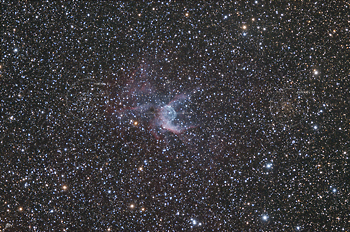 |
CHAMÄLEON + ONJALA OBSERVATORY DeepSky | SITEMAP HOME CHAMÄLEON |
|
 |
|||
| « zurück zur Startseite
galaktische Nebel « back to home galactic nebula |
Großes Bild laden - load large
image 2048 x
1400 Pixel Aufnahmedaten Image data |
NGC 2359 - a Wolf-Rayet nebula in the constellation Unicorn (Monoceros)

NGC 2359, wegen seiner äußeren Form auch als "Thors Helm" genannt, ist ein Emissionsnebel im Sternbild großer Hund. Er umgibt einen massereichen und mit 50.000 Grad Celsius sehr heißen Wolf Rayet Stern mit der Bezeichnung HD 56925 oder WR 7. Der Stern mit einer Helligkeit der 11.5 Größenklasse steht etwas westlich des Zentrums der Blase. NGC 2359 steht in einer Entfernung von ca. 15.000 Lichtjahren zum Sonnensystem, die zentrale Blase hat einen Durchmesser von etwa 20 Lichtjahren.
Wolf Rayet Sterne sind typischerweise charakterisiert durch das Abstoßen großer Mengen von Material als so genannte heftige "Sternwinde". Der oft episodenhaft verlaufende Massenverlust ist enorm und wenn der Wind auf die allgemeine interstellare Materie in der Sternumgebung trifft, bildet sich - ähnlich wie bei einem Supernovarest - eine Faserstruktur aus. Die Ausgangsmassen junger WR Sterne liegen zwischen 10 und 250 Sonnenmassen.
In späteren Stadien sind WR Sterne die freigelegten Kerne ehemals massereicher Sterne. Sie werden keiner der üblichen Spektralklassen zugeordnet, sondern werden in einem eigenen Typ klassifiziert.
Entdeckt wurde NGC 2359 von William Herschel am 31. Januar 1785 und von Wilhelm Tempel wurde im Jahr 1877 ein hellerer Teilbereich als NGC 2361 katalogisiert.
Haffner 6 Neben den klassischen Sternhaufen aus dem Messier, NGC oder IC-Katalog finden gibt es noch spezielle, meist unbekannte Kataloge wie Berkeley, Stock und eben auch Haffner. Die Sternhaufen dieser Kataloge sind meist auf der Basis von Durchmusterungen von Fotoplatten katalogisiert worden. Hans Haffner (1912 - 1977) war Mitte der 50er Jahre Astronom an der Sternwarte Hamburg-Bergedorf tätig, sein Katalog umfasst 27 Objekte.
Haffner 6 ist stark konzentriert und hat einen Durchmesser von ca. 5 Bogenminuten. Die hellsten Sterne haben die 16. Größenklasse, klassifiziert ist der Sternhaufen nach Trumpler als Typ IV 2 r n. Das Alter des Sternhaufens liegt bei knapp 800 Millionen Jahre.
Berkeley 36 ist ein offener Sternhaufen mit einem scheinbaren Durchmesser von 5 Bogenminuten. Er besteht aus etwa 40 Sternen wobei die hellsten Sterne nur 17. Größenklasse haben. Seine Entfernung zum Sonnensystem wird mit 20.000 Lichtjahen angegeben. Der Berkeley Katalog umfasst 104 offenen Sternhaufen, davon wurden 88 auf fotografischen Platten erstmalig durch Astronomen der "University of California at Berkeley" entdeckt und beobachtet.
Object description
NGC 2359, also called "Thor's Helmet" because of its outer shape, is an emission nebula in the constellation of the Great Dog. It surrounds a massive and with 50,000 degrees Celsius very hot Wolf Rayet star with the designation HD 56925 or WR 7. The star with a magnitude 11.5 brightness is located slightly west of the center of the bubble. NGC 2359 stands at a distance of about 15,000 light-years from the solar system, and the central bubble is about 20 light-years across.
Wolf Rayet stars are typically characterized by the ejection of large amounts of material as so-called violent "stellar winds." The mass loss, often episodic, is enormous, and when the wind encounters the general interstellar matter in the stellar neighborhood, a fiber structure forms, much like a supernova remnant. The initial masses of young WR stars range from 10 to 250 solar masses. In later stages WR stars are the exposed cores of formerly massive stars. They are not assigned to any of the usual spectral classes, but are classified in their own type. Another nebula with WR star in the southern night sky is the bipolar nebula NGC 6164/65 in the constellation Norma.
NGC 2359 was discovered by William Herschel on January 31, 1785 and a brighter part of it was catalogued as NGC 2361 by Wilhelm Tempel in 1877.
Haffner 6 Beside the classical star clusters from the Messier, NGC or IC catalogs there are special, mostly unknown catalogs like Berkeley, Stock and Haffner. The star clusters of these catalogs were mostly cataloged on the basis of surveys of photographic plates. Hans Haffner (1912 - 1977) was an astronomer at the Hamburg-Bergedorf Observatory in the mid 1950s, his catalog includes 27 objects. Haffner 6 is strongly concentrated and has a diameter of about 5 arcminutes. The brightest stars have the 16th magnitude class, classified by Trumpler as type IV 2 r n. The age of the cluster is about 800 million years.
 |
Berkeley 36 is an open star
cluster with an apparent diameter of 5 arcminutes. It consists of about 40
stars with the brightest stars being only 17th magnitude. Its distance to the
solar system is given as 20,000 light years. The Berkeley catalog includes 104
open star clusters, 88 of which were first discovered and observed on
photographic plates by astronomers at the University of California at Berkeley.
« Klicken Sie hier oder auf das Vorschaubild zum Laden eines großen Bildes mit Objektbezeichnungen. « « Click here or on the thumbnail to load a large image with object annotations. |
NGC 2359 - a Wolf-Rayet nebula in the constellation Unicorn (Monoceros)
Image data
26.03 + 02.04.2022 - 15 x 600 s, ZWO ASI 071 Pro - Color (cooled)
Telescope: Astro Physics 130mm EDFS + Flattener at f = 850mm
Location: Chamäleon Observatory, Onjala Lodge, Namibia
Image acquisition and processing: DeepSkyStacker, PixInsight + Photoshop
 |
 |
 |
 |
 |
 |
 |
| Sonne | Mond | Sonnensystem | DeepSky | Weitwinkel | Verschiedenes | Spez. Projekte |